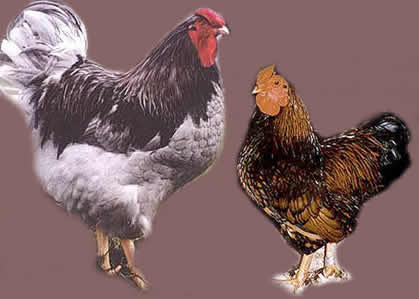\\// Home \\//Genetics Theory \\// Chicken Mutations\\// Chromosome Linkages\\//
\\//
Chicken Variety Genotypes\\//Genetics Calculators\\//
\\// References/Links\\// About / Contact Us\\//
Old URL: http://home.ezweb.com.au/~kazballea/genetics/mutations2.html
Last updated: 29 May, 2007
* Most of the photos on this website originated from "Feathersite",
and "Old English Bantam Club of America" websites, and have been given with
permission by the website administrators.
© Copyright of images belongs to cited photography contributors.
-----------------------------------------------------------------------------
* ![]() Click here for "Print Version"
Click here for "Print Version"
* ![]() Download (..rignt click_Save Target As..) "PDF Version (524 KB)"
Download (..rignt click_Save Target As..) "PDF Version (524 KB)"
-----------------------------------------------------------------------------
This section became quite large, so I've divided the mutation section into three pages:
Mutations: <<Page 1>><<Page2>><<Page3>>
|
Leg Colour Genetics
The gene responsible for white skin is "W+". It is a dominant gene. The gene "w" is the yellow skin gene, recessive to white. These gene alleles affect the "epidermal-outer layer", therefore influence shank/sole colour. The "dermal-under layer" influence to shank colour is determined by the gene alleles "Id" (no pigment) & "id+" (dermal-black pigment). The dermal genes are sex-linked.
The combination of both dermal & white/yellow skin genes alone can produce the following :
* I have modified the above table from Jeffrey, F. (1977) "Bantam Breeding & Genetics" book. |
Another influence to shank colour is the gene Fm (Fibromelanosis). This dominant gene is responsible for the dark flesh colour of the Silkie fowl.
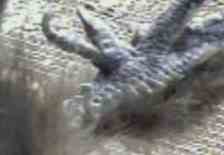
This is a very simple explanation on the genetics. Unfortunately, there is much more, as "plumage colour genes" can influence shank colour significantly. Another major influence on epidermal pigment shank colour is the E (Extended Black) gene, and to a lessor degree - ER (Birchen). These genes enhance black extension on to the epidermal layer.
Plumage Colour Influence:
Diluters of black shank colour:
Blue (Bl/bl), Splash (Bl/Bl), Recessive White (c/c), Mottling (mo/mo), Dominant White (I/I), Gold Dilute (Di/Di), Barring (B/B)
Enhancers of black shank colour:
Extended Black (E/E), Birchen (ER/ER)
Enhancers of horn shank colour:
Red/gold plumage

* Above: Recessive White, Blue & Black birds, all ER (birchen) & White skinned (W+/W+).
I'll give a few examples:
Shank colour |
Dermis |
Epidermis |
Plumage colour |
| White | black (id/id) | white (W/W) | cuckoo (B/B), D. White (I/I) |
| Yellow | none (Id/Id) | yellow (w/w) | some ER- birchen/black * |
| Green (Willow) | none (Id/Id) | yellow (w/w) | black (E or ER) |
| Blue | black (id/id) | white (W/W) | blue (Bl/bl), splash (Bl/Bl), R.white (c/c), heavily mottled (mo/mo), |
| Slate | none (Id/Id) | white (W/W) | black (E or ER) + lavender (lav/lav) |
| Black | none (Id/Id) | white (W/W) | black (E or ER) |
| Horn | none (Id/Id) | yellow (w/w) | red |
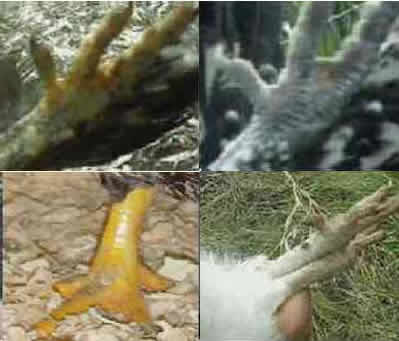
The above are:
-
1 Top left: Willow (e+/e+ wildtype, id+/- dermal pigment & w/w yellow skin),
-
2: Top right: Slate (e+/e+ wildtype, id+/id+ dermal pigment, mo/mo & W+/W+ white skin) &
-
3: Bottom left: Yellow (eWh, eb or ey?, Id/- no dermal pigment & w/w yellow skin)
-
4: Bottom right: White (eWh/eWh wheaten, Id/- no dermal pigment & W+/W+ white skin)
* it is not clearly understood why some ER (eg solid black plumage) breeds/varieties may have yellow shanks, whereas others have black shanks, regardless of the dermal gene allele. That is, an ER, Id/Id (no dermal pigment) bird may be either yellow or black (or willow) shanked. For example, Black: Pekins, Japanese Bantams, Leghorns, etc have yellow shanks. Other examples are Birchen Grey, Brown Red varieties with yellow legs. Sometimes epidermal pigment is sex-influenced with ER, ie more prominent pigment with hens than roosters, eg in some lines the ER roosters are clean yellow legged, yet the hens have epidermal pigment. There is a relationship between white feather undercolour in Blacks & no shank pigment, suggesting a plumage melanotic gene is involved in some lines.
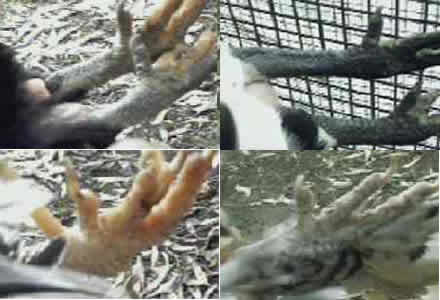
The above are all ER (birchen) at e locus:
- 1 Top left: Willow (ER birchen, Id- no dermal pigment & w/w yellow skin),
- 2: Top right: Slate (ER birchen, I/i+ dominant white & W/w+ white skin, carrying yellow),
- 3: Bottom left: Yellow (ER birchen, Id- no dermal pigment & w/w yellow skin),
- 4: Bottom right: White (ER birchen, id+/id+ dermal pigment, B/b+ Barring, carrying non-barring & W+/W+ white skin)
The level of influence varies greatly from the list above, eg Barring/Cuckoo (B/B) can dilute black dermal colour to white, whereas Blue (Bl/bl+) or RecessiveWhite may only dilute colour to Blue, & exhibition Belgian mottled birds have slate/blue legs.
Shank colour may change from day-old to adult hood. For example, W+ (White skin) and id+ (dermal pigment) is not usually expressed in day-old chicks.
-------------------------------------------
Id Locus Alleles (Id, ida, idc, idM, id+)
There are multiple mutations on this locus, eg:
- Id - Inhibitor of Dermal Melanin,
- ida - Ancona (mottled pigment),
- idc - Cornell Randombred White Leghorn line ( plumage & beak pigment present in dominant whites),
- idM - Massachusetts line (pigment expressed on day-old chicks (E, ER, e+ or c/c), but not expressed with I, except I E chicks - expressed later at approx 10 -12 weeks of age),
- plus id+ wild type (dermal melanin, not expressed on day-old chicks)
------------------------------------------------------
Sex-linked Recessive White Skin (y)
There is a sex-linked recessive white skin mutation - y, but this gene would not normally occur in exhibition flocks. The mutation not only reduces carotenoid pigments to skin/shanks (& egg yolks), but has other deleterious effects to bird health, including significantly reducing growth rates and feed consumption.This sex-linked recessive white-skin (y) allele is expressed in day-old chick shanks (ie, white skin), whereas the autosomal W+ white skin gene is not usually expressed in day-old chick shanks (usually takes approx. 10 weeks for expression of W+).
---------------------------------------------
Bibliography:
Carefoot, W.C. (1986) Creative Poultry Breeding.
Cote, R.S. (1976). A genetic analysis of self black plumage color in the domestic fowl. M.S. Thesis, University of Massachusetts, Amherst.
Crawford, R.D (ed.)(1990). Poultry Breeding and Genetics. Elsevier, Amsterdam.
Jeffrey, F.P. (1976) Bantam Chickens, ABA .
Moore, J.W., Jeffrey, F.P. and Smyth, J.R. Jr. (1972). Sexually dichromatic shank melanization associated with the birchen (ER) allele. Poultry Sci. 51:332-334.
![]()
-----------------------------------------------------------------------------
Eye Colour & Ear Lobe Colour:
(Eye: Sex- linked Brown, Pearl)
(Ear lobe: turquoise, white, Spanish, red)
* Images used in the following examples are from the Feathersite website.
Eye Colour:
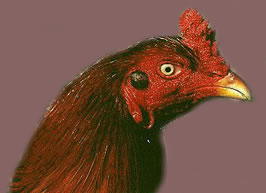
* Pearl Eye-colour
From Dr Okimoto..........
There is a gene for brown eye, but I can't remember to much about it. I'll have to look it up. Eye color is also associated with the E locus alleles (black produces darker eyes) and genes like dominant white will dilute the eye color. I would expect blue and lavendar to do this too.
I had a Blue splash Ameraucana rooster that had bright orange eyes with red streaks in them. I bred him for two generations (the second one back to his daughters) because I like the eye color, but I never got anymore like him. Eye color is pretty much a genetic mystery for chickens.
Smyth in Poultry Breeding and Genetics, 1990 Crawford, ed. Cites a Sex-linked brown eye phenotype (Br). The normal color is called bay. Brown eyed birds are also seen in association with dark shanks and the id^M sex-linked dermal melanin allele. The dominant E allele is associated with brown eye too.
Pearl eye is thought to be recessive to bay eye. I'd think that there were at least two genes involved, but the genetics aren't known. Something inhibits carotinoid deposition and also melanin deposition in these eyes. White skin is known to inhibit carotinoid deposition in the skin, but Smyth claims that it isn't involved in pearl because yellow skinned Cornish can have pearl eyes.
The color I had in my Ameraucana was not the normal bay color it was a bright orange eye with blood red streaks in it. It was pretty striking and could not be confused with the normal bay.
The red color may be carotinoids (the pigment left in fall leaves and can be seen in vegetables like carrots and red peppers).
------------------------------------------------------------------------
Ear lobe colour:
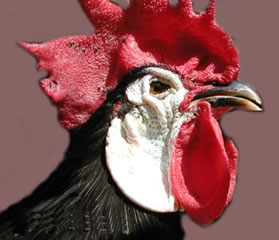
* Spanish - white faced
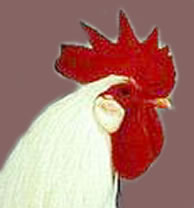
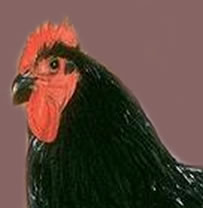
* Left: White Ear-lobes *Right: Red Ear-lobes
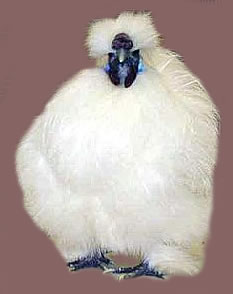
* Turquoise Ear-lobes
Feather types: Frizzle (& mf- modifier frizzle), Silkie,
Soft feather- Hard feather
* Images used in the following examples are from Feathersite, and the OEGBCA website.
The Frizzle gene (F) is incompletely dominant, with exhibition quality Frizzles usually with one dose only of the Frizzle gene (F/f+).
But there is a frizzle modifying gene (mf) which is recessive. The mf gene when homozygous (two doses) is a strong modifier of the frizzle trait. Birds with one dose of the frizzle gene (F/f+) & two doses of the modifying gene (mf/mf) may appear predominantly smooth, & may be mistaken for non-frizzle (& not of exhibition quality). Frizzle birds homozygous for both F & mf (F/F mf/mf) may be mistaken for heterozygous F/f+ (one dose of Frizzle gene) with no modifiers (Mf+/Mf+). It is mentioned in the Hutt book that this mf gene is very common in non-frizzled breeds.
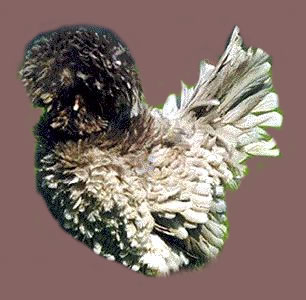
* Frizzle (F) autosomal incomplete dominant
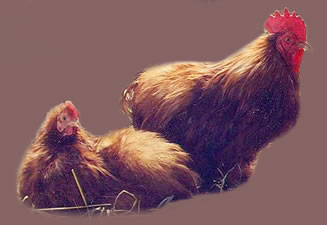
* Silkie- hookless (h)
autosomal recessive
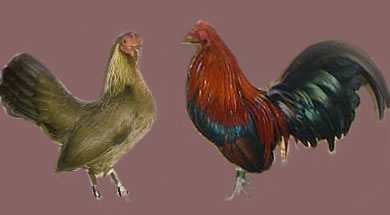
* Hard feathered
(Ha) autosomal incomplete dominant

* Soft Feathered (ha+ plus other modifiers)
----------------------------------------------------------
The following mutations diminish feather quality (eg, feathers prone to breakages, etc).
(source: Poultry Breeding & Genetics).
1. Fray (fr) - autosomal recessive (affects mostly wing flights & tail feathers)
2. Flightless (F1) - autosomal dominant (affects mostly wing flights & tail feathers)
3. Alopecia - autosomal recessive (affects mostly remiges & rectrices)
4. Dysplastiv remiges (dr) - (affects remiges & rectrices, -extreme cases wing coverts)
5. Hypoplasia of tail feathers (Hy) - autosomal dominant (affects tail feathers, resembles rumplessness, but vertebrae normal) Found in Ingie Fowl.
6. Matted Down - polygenic trait
7. Ragged Wing (rw) - autosomal recessive (affects wing flights)
8. Porcupine (pc) - autosomal recessive (spiny quills)
9. Ropy (ropy) - autosomal recessive (sticky down, adults - large wing feathers, sometimes body feathers - roughness)
10. Stringy (st) - recessive (down feathers stringy, very high mortality rate)
11. String-2 (st-2) - autosomal recessive (down sticky, adults - most barbules were absent from wing & tail feathers)
12. Sunsuit (sn) - autosomal recessive (down wiry & sticky, adults - extremities bare of feathers, body better covered)
13. Wiry (wi) - autosomal recessive (down sticky & lacked barbs on distal halves. Adults - mostly wiry barbs of wing flights & tail feathers).
14. Wooly (wo) - autosomal recessive (shortened down- semi-naked, slick shiny feet. Adults - feathers abnormal in structure, rough & incomplete).
15. Wing Patch - expression limited to males, may possibly be linked to the lavender locus.
![]()
-----------------------------------------------------------------------------
Feather Mutations: Foot Feathers- Ptilopody & Stubs, Vulture Hocks
(
Pti-1B, Pti-1L:
Ptilopody 1-Brahma, Ptilopody 1-Langshan
)
( Pti-2, Ptilopody 2 )
( pti-3, Pti-1L: Ptilopody 3 (Pavloff) )
( sb-1 - recessive stubs, Sb-2 - dominant stubs)
(v - vulture hocks)
* Images used in the following examples are from the Feathersite website.
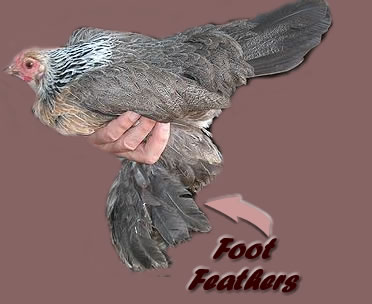
Ptilopody
In "Poultry Breeding & Genetics" (Crawford, 1990), 3 ptilopody loci were noted, eg:
- Pti-1
- Pti-2
- pti-3
2 dominants, 1 recessive
I checked PubMed, found the following on
Identifying the ptilopody (feathered shank) loci of the chicken.
by Somes (1992)
Somes went a step further, identifying 2 alleles on the Pti-1 locus, ie Pti-1B & Pti-1L, the B dominant to L, eg:
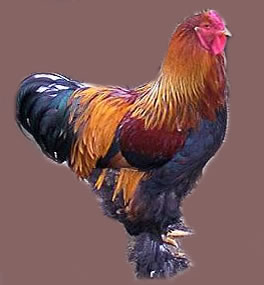
B = allele found in Brahma
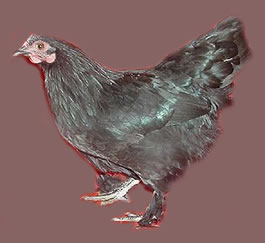
L = allele found in Langshans
- Pti-1B, Pti-1L (& pti-1+ -> wild type)
- Pti-2 (& pti-2+ -> wild type)
- pti-3 (& Pti-3+ -> wild type)
---------------------------
Stubs
-
Ht (Heel tuft feathering)
-
sb-1
-
sb-2
The last two genes came from a study on Rhode Island Reds (Crawford, 1990). It was mentioned that these stub genes may be partially sex-limited, as stubs expression was more prominent in males. Other studies indicated a polygenic basis for the stubs trait (ie, multiple genes involved, acummulative effect on expression).
----------------------------
Vulture Hocks (v)
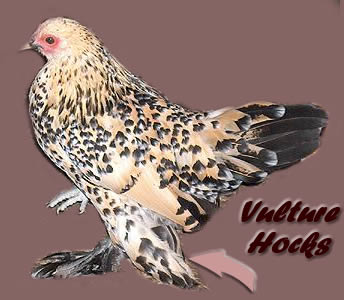
* Vulture Hocks- autosomal recessive (v)
![]()
-----------------------------------------------------------------------------
Feather Placement Mutations:
Crest, Ear tufts, Muff/Beard, Naked Neck, Nakedness
* Images used in the following examples are from the Feathersite website.
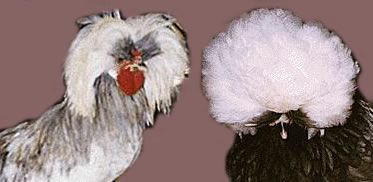
* Crest (Cr) autosomal incomplete dominant
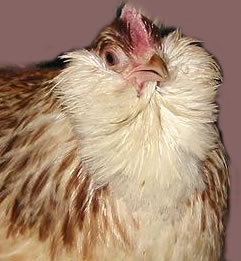
*Muff Beard (Mb) autosomal incomplete dominant
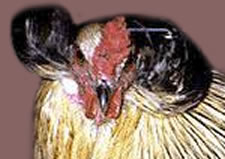
*Ear Tufts (
Et) autosomal, semi-lethal, incomplete dominant
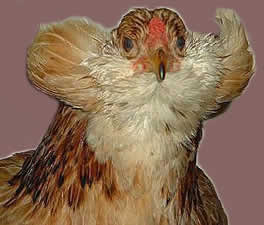
* Both Ear-tufted & Muff/Bearded (Et / Mb)
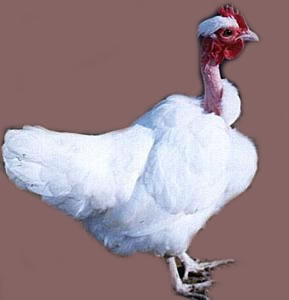 |
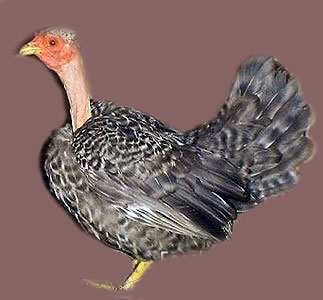 |
* Left- heterozygous Naked Neck (Na/na+), |
Right - homozygous Naked Neck (Na/Na) |
* Na -autosomal, incompletely dominant
There are quite a lot of plumage mutations discussed in “Poultry Breeding and Genetics” eg,
Apterylosis (autosomal nakedness) Ap gene –studied by Sturkie, 1942, condition found in a Rhode Island Red flock
Scaleless (sc)- autosomal recessive gene. Studied by Abbott & Asmundson, 1957, condition found in a New Hampshire flock. Birds are without scales on shanks. Males do not develop spurs.
Sex-linked Naked (n). Studied by Hutt & Sturkie 1938, condition found in a White Leghorn flock.
Ottawa Naked (nk) autosomal recessive (variable expressivity). Trait first observed in 1956
Abnormal feathering (af) autosomal recessive. Studied by Bulfied. Very variable expression, with extreme cases completely naked
--------
Congenital Baldness (ba). Newly hatched chicks with bald areas on the top of their heads. Hutt, 1932 suggested the trait was a simple recessive, but other researchers found variability in inheritance, with Somes believing it was partly a sex-linked recessive trait (although some heterozygous males expressed the trait).
Edema (thigh patch) (ed-1, ed-2), studied by Savage et. al. 1986. Two autosomal recessive genes, at two separate loci.
----------
There are many other mutations listed that effect feather quality (eg, tardy, etc), but the above are the main "naked" genes.
The book only has photos of the scaleless (chicks & rooster), of the naked genes. There are some photos of the sex-linked slow feathering trait- Kn. These have very poor feathering, little coverage (even as adults).
![]()
-----------------------------------------------------------------------------
Feather rate of growth (late/slow feathering alleles, tardy/retarded alleles)
Kn, Ks, K, t, ts
Kn, Ks, K are sex-linked dominant alleles from the Late/Slow Feathering locus.
t, ts (Tardy & Retarded) are autosomal recessive alleles from the Tardy locus.
Slow feathering modifier(s) are believed to exist, these modifying expression of the Slow-feathering K alleles.
![]()
-----------------------------------------------------------------------------
Tail, Flight & Saddle Mutations:
Rumpless (Rp, rp-2),
Long tail (Gt -continual growth), Non-moulting (mt),
8 main tail feathers (ext), Wry tail, Henny feather (Hf),
Surplus Flight Primaries (Sf1, Sf2), Long filoplumes (Lf)
* Images used in the following examples are from the Feathersite website.
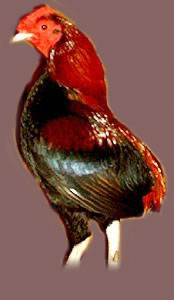
* Rumpless
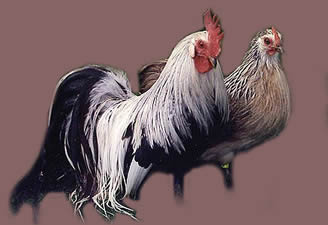
* Long tailed

* Henny Feathered - Hf autosomal incomplete dominant
![]()
-----------------------------------------------------------------------------
Comb types: single, pea, rose, buttercup, breda , duplex, rough, sprigs
* Images used in the following examples are from the Feathersite website.
Comb Types:

* Modified Rose Combed - Trifid (R, p+/p+) & smooth comb, possibly- hel
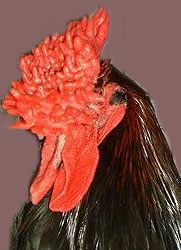
* Redcap - modified Rosecomb (R p+/p+)
“single comb is recessive to all other comb types except....Breda.“
Different loci, recessives, so a good example of “Epistasis”, ie where one gene interferes with the expression of another ( epistasis ).
For example, d/d,r/r,p/p,bd/bd is genetically combless, suppressing single comb. A d/d,r/r,P/P,bd/bd bird is still combless, but suppressing pea comb, & so on.... That is, the Breda combless gene (bd), when homozygous, suppresses all other comb types, regardless of d, r & p loci. Similar to recessive white gene (c/c) suppressing all colour in plumage, regardless of all colour/pattern genes present.
* In Hutt, Genetics of the Fowl:
-“Strictly speaking, pea & rose are not dominant to single comb but epistatic to it. Single comb is “Hypostatic” to these two but epistatic to the combless type of the Breda (Hutt, p88)”
-“ In Breda males, two small papillae on each side of the median line back from the upper beak indicate the duplex condition, although the birds appear practically combless (p87)”
In Crawford, p194: Dv allele is dominant to the Dc allele. The wide cavernous nostrils are expressed with homozygosity for Dv allele but not Dv/d+. Also expressed with Dv/Dc, but only in association with Dv allele.
The Breda breed has the wide-open nostril trait ( chickenbreeds website-Breda fowl )
----------------------------
The P gene: pea comb & breast ridge/reduced feather characteristics is a good example of “Pleiotropy” ie the effect of a single gene on more than one characteristic ( Pleiotropy )
-----------------------------
In Poultry Breeding & Genetics:
Page 192
Poor fertility is associated with R/R males in at least several breeds. Fertility of R/r+ and r+/r+ males & of all 3 genotypes of females is perfectly normal. Sperm cells from R/R males have some fertilizing capability, but they cannot compete with sperm cells from R/r+ males in multiple sire matings. This can explain persistance of the single comb allele in rose-combed populations.
Page 448
A large single gene effect is the poor fertility of males homozygous for the rose comb gene. Mating frequency is lower and duration of fertility after a single insemination is shorter for R/R males. The motility of their spermatozoa after storage is inferior and certain enzymatic activities differ. The He locus which modifies the appearance of rose comb may also be associated with a difference in male fertility.
----------------------------
Comb Modifiers:
There are two "Rough/Smooth" comb alleles listed, that modify comb texture (especially noticable in rosecombs), eg:
- He+ (Rough, also produces more spikes in single comb) &
- hel (Smooth)
* notice the first is considered the wild type.
--------------------------
A modifier described by Warren is "Spike Blade Comb" - sb. This one modifies the single comb by ending the comb in a single spike instead of the usual broad oblong blade. It is generally expressed as an autosomal recessive gene, but with variable penetrance (small percentage of heterozygotes express the trait, & a small percentage of homozygotes suppressed, no expression).
--------------------------
Other comb modifiers have been studied, but without genes formally named. For example:
- Trifid - three-pronged (rosecomb modifier, eg found in Silkies, deWatermael)
- Side sprigs (single comb modifier)
- Multiplex (single comb modifier - multiple combs)
![]()
-----------------------------------------------------------------------------
Spurs & Toes (multiple spurs, hen spurs, 5-toes, Brachydactyl )
Brachydactyly
Sevebrovsky noted with the ptilopody birds he studied, that all with the "tip-type" phenotype (feathers on the outer toes, little on middle toe) were brachydactylous of the outer toe. Because of this & other studies it was hypothesised that the Brachydactyly trait may actually be due to a ptilopody (feathered shank) gene (Crawford, 1990). The problem is, within Danforth's studies, birds with brachydactyly & no foot feathers were noted in his research (see Hutt, p56).

The shorter outer toe trait has been given the mutation name: Brachydactyly - By gene (autosomal incomplete dominant). There is a strong correlation with foot feathering - ptilopody (feathered shank) & the brachydactyly trait. So some researchers believe the Brachydactyly trait is not a separate gene, but one of the ptilopody genes. The problem is, some brachydactyly, clean-legged birds have segregated from test crosses.
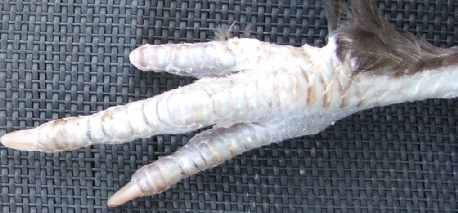
* In Crawford, it is mentioned that birds homozygous for foot feathers, have higher occurrence of brachydactyly (& more pronounced features), but as you can see above, birds with poor foot feathers may also be brachydactylous.
![]()
-----------------------------------------------------------------------------
Leg Length (Creeper gene, Cornish Gene)
* Images used in the following examples are from the Feathersite website.
There is some very good information & references on the Creeper gene in both Crawford (pp 223-224) & Hutt (pp 58-63) books. It seems Cp has been a favourite topic for W. Landuaer, with decades of study on the subject. There are many articles published by him over the years. Some other interesting genes are Cl (short-legged Cornish lethal) & Mp (Ametapodia). These 2 have similar traits to Cp, with reduction to leg length & lethal when homozygous. Mp is found on the same chromosome as Creeper, but not as closely linked to Rosecomb gene as Cp is. It is a more debilitating gene, with heterozygotes (Mp/mp) badly deformed. There is another semi-lethal gene affecting leg length shl (Shankless).
The chapters on the short-legged Cornish (Cl) gene are a very good read. Studies have found that more than one gene was responsible for the short-legged phenotype in Cornish. Intermediate leg lengths were produced in F1 crosses with Leghorns, but offspring in the 2nd generation (F2) ranged from short-legged to some that were longer-legged than the parent (P1) leghorns.
References:
Crawford, R.D. (1990). Poultry Breeding & Genetics. Elsvier , N.Y.
Hutt, F.B. (1949). Genetics of the Fowl”. McGraw-Hill , N.Y.
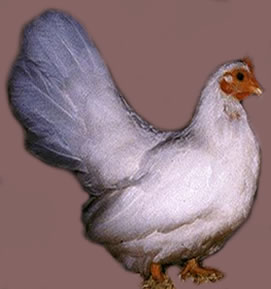
* Creeper Cp - shortlegged,
-
autosomal semi-lethal incomplete dominant
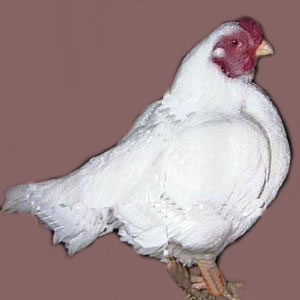
* Cornish Lethal - Cl, shortlegged,
-
autosomal semi-lethal incomplete dominant
![]()
-----------------------------------------------------------------------------
Size Mutations (Sex-Linked Dwarfism, Recessive Dwarfism, Bantam Genes, etc)
* Images used in the following examples are from the Feathersite website.
The following information is mostly from the book "Poultry Breeding and Genetics"
Dwarfing Genes:
There have been four loci identified with dwarfing mutations, one locus with multiple mutation alleles:
- Z
- rg
- adw
- dw, dwM, dwB
* Z "Dominant Sex-linked Dwarfism"– found in Golden Sebrights (Maw 1935, crossed Light Brahma with Gold Sebrights).
* rg "Recessive Sex-linked Dwarfism"– Black Rosecomb Bantams (Godfrey 1953, crossed Barred Plymouth Rock with Black Rosecomb bantams)
* adw "Autosomal Dwarfism"- mutation occurred in Cornell K strain White Leghorns (Cole 1973)
* dw, dwM, dwB "Sex-linked Dwarfism"- closely linked to silver-gold & slow-rapid feathering loci.
-------------------------
- dw Mutation appeared in a New Hampshire flock (Hutt 1959)
- dwB found in Golden Sebright (Custodio & Jaap 1973) (dwB dominant over dw)
dwM found in a meat-type line (Hsu et al 1975). (inheritance relationship with other locus alleles not determined).
Generally large & bantam crosses produced F1 offspring intermediate in size (sometimes closer to bantam size). F2 offspring had the greatest variation in size. An exception was found in a study by Danforth (1929). There was variation between bantam breeds when he crossed a Millefleur Belgian d'Uccle Bantam male with Sebright females. Some F1 progeny were larger than the parents, & in later generations birds both larger and smaller than the parental types were obtained.
I haven't crossed Standard size to bantams, but there is a lot of difference in size between various bantam breeds I have crossed, and sometimes there is obvious variation in sizes within a breed, between lines. Usually the first crosses are intermediate in size, but I've had results similar to Danforth, where F1 offspring were larger than both parent birds (eg Orpington Bantam X Indian Game Bantam, resulting F1 were close to commercial layer size, and unrelated d'Uccle X d'Uccle, some F1 offspring larger than parents, etc). Something that I thought was amiss in “Poultry Breeding and Genetics” was that there was little mention in the chapter of mutations that INCREASE size. Crosses were made between bantam breeds to large Standard size breeds, these much larger than the Red Jungle Fowl –wild type. Obviously mutations that increase size would need to be taken into consideration when determining dwarfing genes.
There is another chapter in the book, dealing with studies on the dw gene, for possible commercial use. Usually these dwarfing genes have little in the way of deleterious effects to general health (sometimes heath gains), but of course there are few production issues, eg reduced egg size, body weights, etc (tend to be more efficient with feed consumption to production outputs though).
![]()
-----------------------------------------------------------------------------
-End of Page 2 (of 3) Poultry Mutations-
|
-----------------------------------------------------------------------------
\\// Home \\//Genetics Theory \\// Chicken Mutations\\// Chromosome Linkages\\// Chicken Variety Genotypes\\//
\\//Genetics Calculators\\// References/Links\\// About\\//







